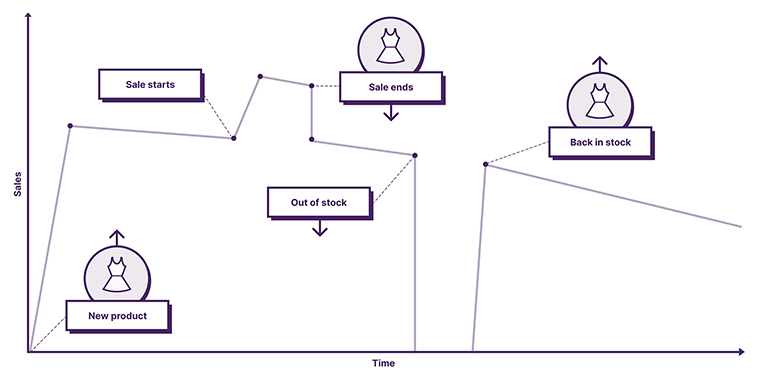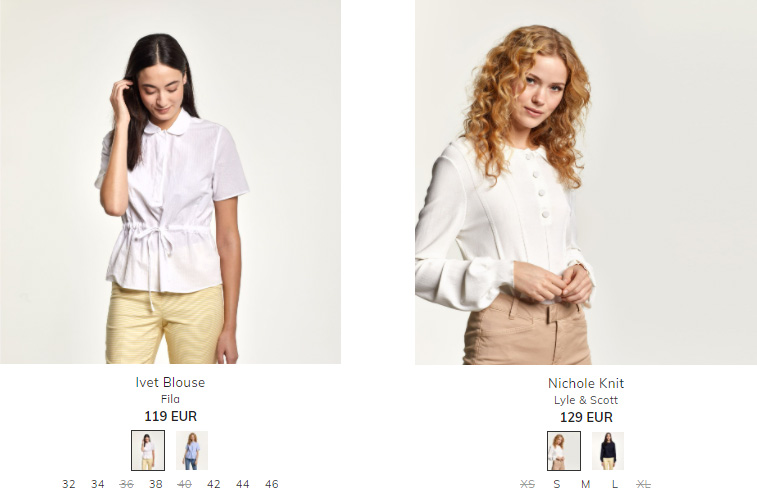Product listing relevance¶
Voyado Elevate uses several different algorithms to determine the relevance of a product given its current context, including product life cycle analysis, visitor behavioral insights, exposure strategies, merchandising actions such as boosting or burying, as well as business domain knowledge. Together, these algorithms provide a powerful ranking which in turn results in highly relevant general product listings for any given context.
The product relevance ranking is a fundamental part of the different types of product listings, such as search results and category listings. It also plays a part of the different product recommendations.
Trend sensitivity¶
Relevancy of a product changes over time. Voyado Elevate uses various behavior driven algorithms to calculate momentary relevance in order to show what is relevant right now. This includes an iteration of Voyado's own patented Top Seller algorithm (US Patent No. 10 528 577) which intelligently balances trending products with consistent sellers in product listings.
Objective driven relevance¶
Exposure strategies is a concept that enables merchandisers to have Voyado Elevate optimise its algorithms for product exposure towards different business objectives.
There are three different exposure strategies available:
- Expose higher priced products (Revenue focus)
- Expose high margin products (Profit focus)
- Expose products that sell more (Conversion focus)
For more information, see Exposure strategies.
Product life cycle¶
The product ranking not only understands customer behavior, but also important events in the product life cycle. These events include when a product is new, is being put on sale, or becoming out of stock. This affects multiple areas of ranking: search results, category listings, phrase suggestions, product suggestions, alternative recommendations, complementary recommendations, and facet relevance.

An example of life cycle understanding is that Voyado Elevate understands that a high performing product on sale doesn't necessarily keep selling well when the sale is over. Another example is that it understands that out of stock products don't sell well because they can't be purchased rather than them being unpopular. It might even be that the high popularity caused some products to quickly become out of stock in the first place.
The newness of products is another part of a product's life cycle. New products needs increased exposure to acquire a correct evaluation of their popularity, but exploratory exposure comes at the cost of exploiting the insights of how they perform. Meaning unpopular new products shouldn't keep taking up screen real estate that can be better used by popular products once they've had the chance to prove themselves. Voyado Elevate caters for this through greater initial exposure of new products with especially reactive and clever ranking of this segment to avoid overexposure.
Product score smoothing¶
Products are almost always available in a varying number of sizes. For example, one blouse could be available in 8 different sizes, while another blouse can have a more coarse size scale and only be available in 5 sizes. Without understanding of the data structure, a comparison of interactions on these products and SKU:s can easily get skewed.

With Voyado Elevate, these products are fairly compared through product score smoothing, which is made possible through the well defined data model. Furthermore, product score smoothing enables a fair and relevant ranking for partially out of stock products. This means that the more relative sizes a product is available in, the more likely it will sell, while simultaneously taking the individual popularity of each size into account.
Product property analysis¶
Some product properties are critical to provide a relevant result, for example in the fashion and lifestyle domain, such as imagery and stock levels. Through image availability and stock knowledge, Voyado Elevate heavily bury products lacking imagery or being completely out of stock. This is made automatically and is revoked once the product is back in stock or gets accessible imagery.
Boost and Bury¶
Boost and bury can be used to either to temporarily increase or decrease the strategy score of selected products in a market. Boosted products will gain positions, while buried products will suppress positions in search results, category pages, and other locations where applicable.